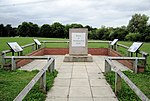Newcastle University Boat Club
1911 establishments in EnglandEngvarB from December 2018Newcastle UniversityRowing clubs in EnglandSports clubs and teams established in 1911 ... and 1 more
University and college rowing clubs in the United Kingdom

Newcastle University Boat Club (NUBC) is the rowing club of Newcastle University, UK. Established in March 1911 as the boat club for Armstrong College, it celebrated its centenary in 2011, when was also appointed High Performance Programme for heavyweight men and women by British Rowing. In the past 20 years current students and alumni won 60 international vests for GB.
Excerpt from the Wikipedia article Newcastle University Boat Club (License: CC BY-SA 3.0, Authors, Images).Newcastle University Boat Club
Keelman's Way,
Geographical coordinates (GPS) Address Nearby Places Show on map
Geographical coordinates (GPS)
| Latitude | Longitude |
|---|---|
| N 54.9798 ° | E -1.7436 ° |
Address
Newcastle University Water Sports Centre
Keelman's Way
NE15 8LR
England, United Kingdom
Open on Google Maps





